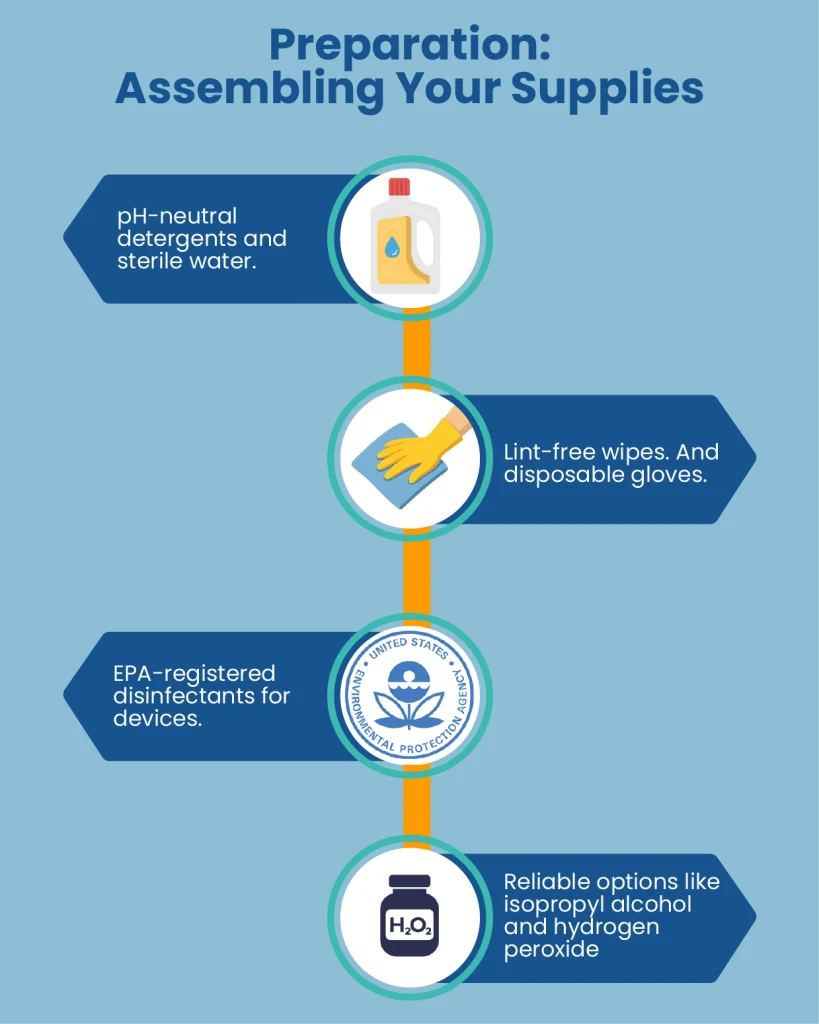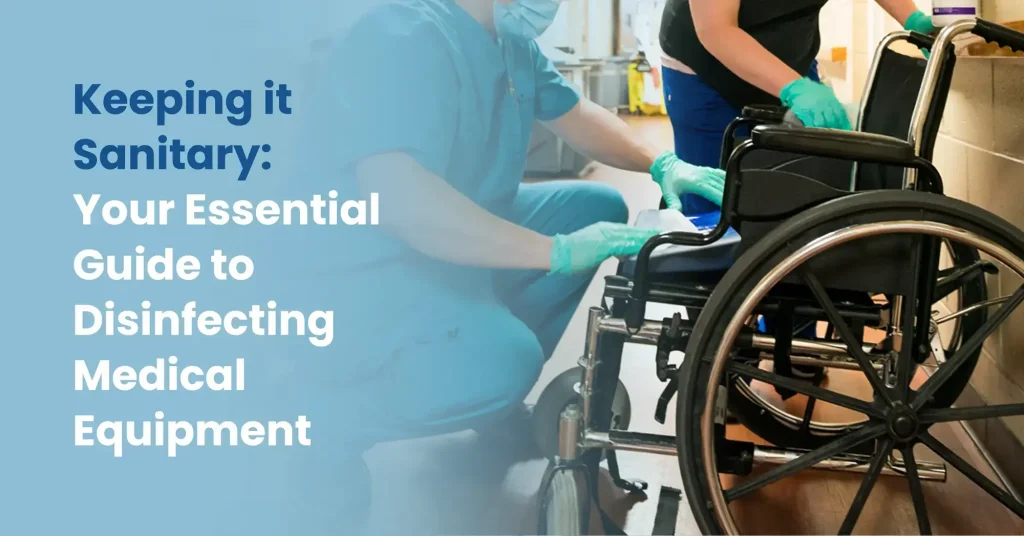Your medical equipment serves an essential role in your health. Proper disinfection goes beyond simple cleaning. It creates a vital barrier against infection. This practice safeguards both you and your caregivers. Effective sanitation prevents harmful pathogen transmission.
Many individuals feel uncertain about cleaning sensitive health products. This guide demystifies the entire sterilization process. We explore proven methods for various device categories. These protocols will ensure your medical tools remain safe and reliable.
Understanding the Cleaning Range:
Cleaning and disinfecting are different but closely linked. Cleaning takes away small particles from surfaces. While disinfecting targets and kills harmful germs. Sterilization goes even further. It offers the highest level of germ removal.”
Consider this comparison with hand hygiene. Washing with soap constitutes cleaning. Using alcohol-based sanitizer represents disinfection. Surgical scrub protocols achieve sterilization. Most home medical products require the first two levels only. Understanding this hierarchy ensures appropriate care.
Preparation: Assembling Your Supplies
Following essentials items will be needed for the sanitation process:
- pH-neutral detergents and sterile water
- Lint-free wipes. And disposable gloves
- EPA-registered disinfectants for devices
- Reliable options like isopropyl alcohol and hydrogen peroxide
Manufacturer’s instructions for specific equipment
Always review the manufacturer’s guidance for specific equipment. These instructions provide critical material compatibility information. Create a dedicated cleaning station within your home. This organized approach streamlines the maintenance routine for all medical products.

Systematic Cleaning Methodology
Begin by disconnecting electronic devices from power sources. Remove batteries from portable medical equipment when possible. Pre-clean surfaces with designated cloths and appropriate cleaners. Focus particularly on control interfaces and handling surfaces.
These high-contact zones typically show heaviest microbial colonization. Complete the initial cleaning phase with thorough drying. Introduce your selected disinfectant according to label directions. Maintain the required surface contact time for optimal efficacy. This systematic approach ensures consistent results.
Managing Durable Medical Equipment
Durable devices include patient monitors and diagnostic equipment. This category also encompasses mobility aids and hospital beds. These products generally feature non-porous construction materials. They tolerate more robust cleaning protocols than delicate instruments.
Disinfectant wipes provide convenient solutions for these surfaces. Spray-based products offer alternative application methods. Always verify material compatibility before using new chemicals. Pay special attention to mechanical joints and structural crevices. These areas often accumulate environmental contaminants.
Caring for Sensitive Electronic Devices
Electronic health monitors demand particular consideration. Harsh chemicals can compromise optical sensors and touch interfaces. Avoid liquid penetration around button peripherals and data ports. Lightly moistened wipes provide the safest cleaning method.
Ensure evaporation before device reactivation. Store disinfected equipment in climate-controlled environments. Monitor battery compartments for corrosion during routine cleaning. Dry everything completely. These precautions extend the functional lifespan of valuable medical equipment.
Establishing Maintenance Frequency
Develop a rational schedule for equipment sanitation. Immediate post-procedure cleaning applies to contact-based devices. Ventilator circuits and suction equipment require this attention. General surface disinfection suits less critical patient care equipment.
Document your cleaning procedures for consistency. This practice helps identify maintenance patterns over time. It also provides valuable documentation for healthcare providers. Regular maintenance prevents biofilm development on reusable products.
Recognizing Equipment Replacement Signs
All medical equipment have finite service lives. Visible cracks or material degradation indicate replacement time. Electrical malfunctions or erratic readings suggest component failure. Persistent odor despite thorough cleaning signals deep contamination.
Follow the replacement schedule suggested by the manufacturer. Some single-use medical products can’t be safely reprocessed. Using compromised equipment risks patient safety. It also risks treatment accuracy. Consult healthcare providers about proper disposal methods for medical waste.
| Disinfectant Type | Best For Equipment Examples | Key Advantages | Important Safety Notes |
| Isopropyl Alcohol (70%) | Glucose meters, thermometer probes, scissors. | Fast-drying, effective against many common bacteria. | Can damage plastics and rubber over time; ensure good ventilation. |
| Diluted Bleach Solution | Walkers, commodes, bed rails, non-porous surfaces. | A powerful, broad-spectrum germicide; very cost-effective. | Can corrode metals; must be rinsed after required contact time. |
| Hydrogen Peroxide (3%) | Respiratory equipment parts, some surgical tools. | Breaks down into water and oxygen; less toxic residue. | Can cause skin irritation; may discolor some surfaces with repeated use. |
| EPA-Registered Wipes | Blood pressure cuffs, stethoscopes, general surfaces. | Pre-moistened and convenient; precise contact times listed. | Do not reuse wipes on multiple devices to prevent cross-contamination. |
Implementing Comprehensive Safety Protocols
Medical equipment disinfection is a fundamental health practice. It integrates seamlessly into daily care routines. This discipline provides significant protection against healthcare-associated infections. Properly maintained devices deliver more accurate clinical data.
Your commitment to equipment care reflects broader health stewardship. These practices demonstrate proactive engagement with personal wellness. Each cleaning session represents an investment in long-term wellbeing. This systematic approach to medical device management benefits everyone involved.
FAQ’s
What’s cleaning and disinfecting?
Cleaning removes visible particles. Disinfecting kills invisible germs.
What supplies do I need?
- pH-neutral detergent
- sterile water
- lint-free wipes
- gloves.
Is alcohol safe for medical equipment?
It works on hard surfaces. It can damage some plastics.
How clean electronic devices?
Use lightly dampened wipes only. Avoid moisture in ports.
What is contact time?
It’s how long disinfectant must stay wet. This kills germs properly.
Can I reuse disposable equipment?
Never reuse single-use products. This prevents infection risks.
When should I replace equipment?
Look for cracks or damage. Note any malfunctioning parts.
What are EPA-registered products?
They’re approved by government. They meet safety standards.
How should I store clean equipment?
Keep in dry and clean areas. Protect from dust and moisture.

